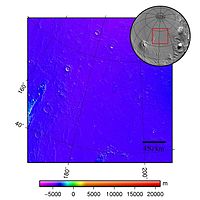Arcadia Planitia
 |
|
| Coordinates | 47°12′N 184°18′E / 47.2°N 184.3°ECoordinates: 47°12′N 184°18′E / 47.2°N 184.3°E |
|---|---|
Arcadia Planitia is a smooth plain with fresh lava flows and Amazonian volcanic flows on Mars. It was named by Giovanni Schiaparelli in 1882 after the Arcadia region of ancient Greece. It dates from the Amazonian period's Arcadia formation's lava flows and small cinder cones. It includes a more recently developed large region of aeolian materials derived from periglacial processes. It is located northwest of the Tharsis region in the northern lowlands, spanning the region 40-60° North and 150-180° West in the Cebrenia quadrangle and centered at 47°12′N 184°18′E / 47.2°N 184.3°E. Part of it is in the Diacria quadrangle. Arcadia marks a transition from the thinly cratered terrain to its north and the very old cratered terrain to the south. On its east it runs into the Alba Mons volcanoes. Its elevation relative to the geodetic datum varies between 0 and -3 km.
In a lot of the low areas of Arcadia, one finds grooves and sub-parallel ridges. These indicate movement of near surface materials and are similar to features on earth where near surface materials flow together very slowly as helped by the freezing and thawing of water located between ground layers. This supports the proposition of ground ice in the near surface of Mars in this area. This area represents an area of interest for scientists to investigate further.
...
Wikipedia
